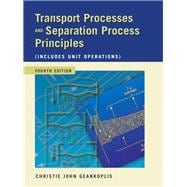
Note: Supplemental materials are not guaranteed with Rental or Used book purchases.
Purchase Benefits
Looking to rent a book? Rent Transport Processes and Separation Process Principles (Includes Unit Operations) [ISBN: 9780131013674] for the semester, quarter, and short term or search our site for other textbooks by Geankoplis, Christie John. Renting a textbook can save you up to 90% from the cost of buying.
CHRISTIE JOHN GEANKOPLIS is a Professor of Chemical Engineering and Materials Science at the University of Minnesota. His current research interests involve transport processes, biochemical reactor engineering, mass transfer in liquid solutions, and diffusion and/or reaction in porous solids. He holds a Ph.D. in Chemical Engineering from the University of Pennsylvania.
I. TRANSPORT PROCESSES: MOMENTUM, HEAT, AND MASS.
1. Introduction to Engineering Principles and Units.II. SEPARATION PROCESS PRINCIPLES (INCLUDES UNIT OPERATIONS).
The New copy of this book will include any supplemental materials advertised. Please check the title of the book to determine if it should include any access cards, study guides, lab manuals, CDs, etc.
The Used, Rental and eBook copies of this book are not guaranteed to include any supplemental materials. Typically, only the book itself is included. This is true even if the title states it includes any access cards, study guides, lab manuals, CDs, etc.